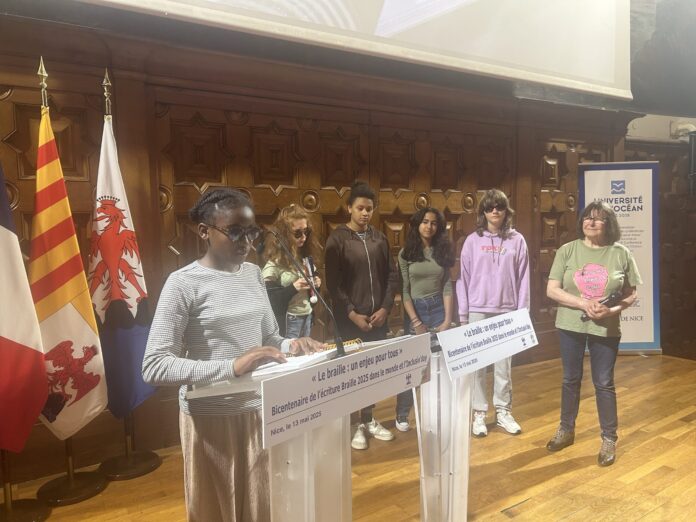The bicentenary of braille was celebrated at the Mediterranean University Center of Nice on the occasion of Inclusive Day. A day dedicated to the inclusion of visually impaired and blind people.
This Tuesday, May 13, the amphitheater of the Mediterranean University Center (CUM) resonates with emotion and gratitude. On the occasion of Inclusive Day, the city of Nice celebrates the bicentenary of the birth of braille, this tactile writing system invented by Louis Braille and internationally recognized in 1878. A day focused on inclusion, culture, and accessibility.
Present for this tribute, Jean-Luc Gagliolo, Deputy Mayor for Culture, Heritage, and Books, wished to honor deserving individuals, often faced with challenges but displaying great strength. Among the audience, visually impaired and blind individuals came to share this symbolic moment.
“Braille allows one to emerge from darkness”
Professor Gilles Mottet, a teacher at the Nice Conservatory, presented his book The Venerable Larch. A special work: it was transcribed into braille, making its content accessible to all. The story he tells is of a tree struck by lightning. An opening in its trunk, born of its wound, allows it to make music with the wind. A poetic metaphor for difference becoming an asset. “Braille allows one to emerge from darkness”, he said, as a reminder of what this alphabet represents for those who use it: a bridge to knowledge and freedom.
Writing as a tool for structuring thought
Michel Farfallini, blind and a former employee of the Nice city hall for 30 years, is one of the witnesses to the concrete impact of braille in daily life. Thanks to it, he was able to read, write reports, and maintain his professional autonomy. To those who claim that everything can now be replaced by auditory devices, he responds with conviction: “Writing structures thought, helps retain spelling, and improves memory. Tactile memory is somewhat equivalent to visual memory.”
Indeed, braille is not limited to the alphabet. There is also mathematical braille, which allows one to handle equations, as well as musical braille. The system relies on six raised dots, small enough to fit under the pad of a finger, thereby reproducing all the letters and symbols necessary for reading.
To conclude this moving morning, students from Port Lympia School, both sighted and non-sighted, came together to read excerpts from The Venerable Larch. A strong illustration of inclusion from a young age, in a society where equal access to culture and education is essential.


